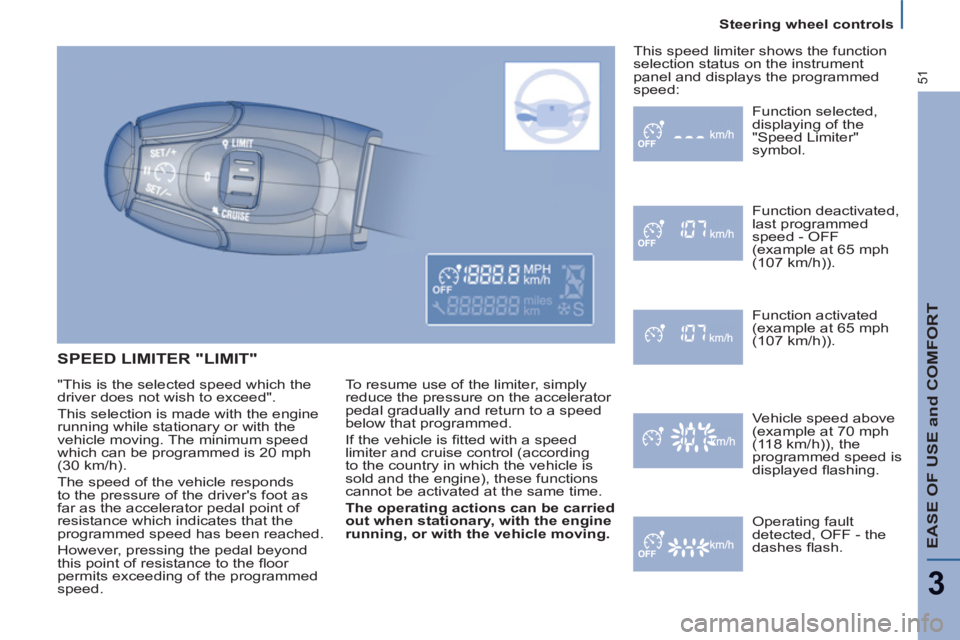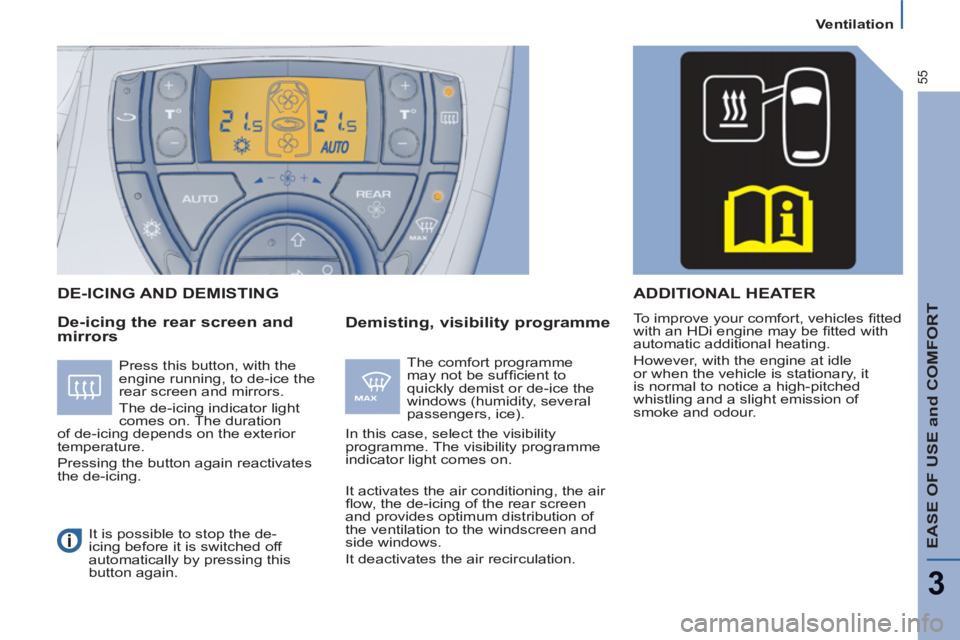Page 53 of 234

Steering wheel controls
EASE OF USE and COMFORT
3
51
SPEED LIMITER "LIMIT"
To resume use of the limiter, simply
reduce the pressure on the accelerator
pedal gradually and return to a speed
below that programmed.
If the vehicle is fi tted with a speed
limiter and cruise control (according
to the country in which the vehicle is
sold and the engine), these functions
cannot be activated at the same time
.
The operating actions can be carried
out when stationary, with the engine
running, or with the vehicle moving.
Function selected,
displaying of the
"Speed Limiter"
symbol.
Function deactivated,
last programmed
speed - OFF
(example at 65 mph
(107 km/h)).
Function activated
(example at 65 mph
(107 km/h)).
Vehicle speed above
(example at 70 mph
(118 km/h)), the
programmed speed is
displayed fl ashing.
Operating fault
detected,
OFF - the
dashes fl ash. This speed limiter shows the function
selection status on the instrument
panel and displays the programmed
speed:
"This is the selected speed which the
driver does not wish to exceed".
This selection is made with the engine
running while stationary or with the
vehicle moving. The minimum speed
which can be programmed is 20 mph
(30 km/h).
The speed of the vehicle responds
to the pressure of the driver's foot as
far as the accelerator pedal point of
resistance which indicates that the
programmed speed has been reached.
However, pressing the pedal beyond
this point of resistance to the fl oor
permits exceeding of the programmed
speed.
Page 54 of 234
Steering mounted controls
52
Selecting the function
- Place the dial in the LIMIT
position.
The limiter is selected but is not yet
active. The display indicates the
last programmed speed.
Programming a speed
A speed can be programmed without
activating the limiter but with the
engine running.
To memorise a speed higher than the
previous one:
- press the Set +
button.
A brief press increases the speed by
1 mph (km/h).
A maintained press increases the
speed in steps of 5 mph (km/h).
Activation/Deactivation (off)
Pressing this button once activates
the limiter, pressing the button again
deactivates it (OFF).
To memorise a speed lower than the
previous one:
- press the Set -
button.
A brief press decreases the speed by
1 mph (km/h).
A maintained press decreases the
speed in steps of 5 mph (km/h).
Page 57 of 234

EASE OF USE and COMFORT
3
55
Ventilation
De-icing the rear screen and
mirrors
Demisting, visibility programme DE-ICING AND DEMI
STING
The comfort programme
may not be suffi cient to
quickly demist or de-ice the
windows (humidity, several
passengers, ice).
In this case, select the visibility
programme. The visibility programme
indicator light comes on.
It activates the air conditioning, the air
fl ow, the de-icing of the rear screen
and provides optimum distribution of
the ventilation to the windscreen and
side windows.
It deactivates the air recirculation. Press this button, with the
engine running, to de-ice the
rear screen and mirrors.
The de-icing indicator light
comes on. The duration
of de-icing depends on the exterior
temperature.
Pressing the button again reactivates
the de-icing.
It is possible to stop the de-
icing before it is switched off
automatically by pressing this
button again.
ADDITIONAL HEATER
To improve your comfort, vehicles fi tted
with an HDi engine may be fi tted with
automatic additional heating.
However, with the engine at idle
or when the vehicle is stationary, it
is normal to notice a high-pitched
whistling and a slight emission of
smoke and odour.
Page 58 of 234

56
Ventilation
Do not cover the sunshine sensor
located in the centre of the fascia.
This is used to regulate the air
conditioning. Located on the centre console, the
control panel is to the right of the gear
lever.
1 - AUTO mode
This is the normal air
conditioning operating mode.
Refer to the beginning of the
"Ventilation" section of chapter 6.
The driver and front passenger can
each adjust the air temperature to suit
their requirements.
They can also activate or disarm the
rear ventilation adjustment controls.
For your comfort, the settings selected
when the ignition is switched off will be
retained when it is switched on again, if the
temperature in the passenger compartment
has not changed signifi cantly; otherwise,
operation will resume in automatic mode.
- Press the "AUTO"
button.
Depending on the comfort temperature
selected, the system controls the air
distribution, fl ow and intake so that the
passenger compartment is comfortable
and has an adequate circulation of air.
You do not have to make any further
adjustments.
When the engine is cold, in order
to prevent a rush of cold air, the
ventilation will reach its optimum
level
progressively.
The "AUTO"
symbol is displayed.
Page 64 of 234

62
Seats
3 - Seat back angle adjustment
Tilt the control to the front or the rear to
obtain the angle required.
The electrical functions of the seats
are cancelled one minute after the
ignition has been switched off.
4 - Driver's seat lumbar adjustment
(mechanical)
Raise or lower the lever to obtain the
correct position.
5 - Head restraint height and angle
adjustment (manual)
To raise or lower the head restraint,
pull it forwards, then slide it.
Never drive with the head
restraints removed; they must be
in place and correctly adjusted.
6 - Rotating of seats (mechanical)
Place the seat back in the upright
position.
Place the seat in the highest
intermediate longitudinal position.
On the driver's side, push the steering
wheel, apply the handbrake. To
allow rotation of the seat, lower the
handbrake handle pulling on the end.
Pull the control upwards and rotate the
seat inwards.
This rotating operation must
be carried out with the engine
switched off. The handbrake,
the lever of which is now in the lower
position, remains applied. Do not forget
to raise the lever and release the brake
before setting off.
Driving with a passenger seated facing
the rear is prohibited. For further information regarding
the disengaging of the handbrake,
refer to the "Driving safety" section
of chapter 4. The setting is correct when the upper
edge of the head restraint is level with
the top of the head.
To remove the head restraint, place it
in the high position, lift the tab using a
coin and pull upwards and forwards at
the same time.
To re-install, engage the head restraint
rods in the holes, making sure they are
aligned with the seat back.
Page 65 of 234

EASE OF USE and COMFORT
3
63
Seats
Memorising seat positions
Two driving positions can be
memorised, using buttons M/1
and
M/2
.
These are located on the side of the
seat:
- Place the ignition key in the
"running" position (2nd notch),
-
Adjust your seat,
-
Press button M
, then button 1
for
a fi rst driving position within four
seconds.
Repeat the same actions on buttons M
and 2
to store another driving position.
An audible signal confi rms that a
position has been memorised.
Memorising a new position cancels the
previous one.
Activating a memorised driving
position
Front heated seat controls
When the engine is running, the front
seats can be heated separately.
Use the adjustment controls located on
the side of each front seat to switch on
and select the self-regulated level of
heating:
1:
Low.
2:
Medium.
3:
High.
0:
Off. After recalling a memorised
position fi ve times in succession,
the function will be cancelled until
the engine is started.
Engine running
- Keep button 1
or 2
pressed down
until the end of setting of the
corresponding memorised position.
Engine off
- Briefl y press button 1
or 2
to recall
the corresponding memorised
position.
Page 73 of 234
EASE OF USE and COMFORT
3
71
Seats
The centre seat may be installed
in the central position in row 2 and
in the left side position in row 3.
MODULARITY AND POSSIBLE SEAT CONFIGURATIONS
Examples of various
arrangements combining
pleasure and practicality:
The various operations modifying
the existing confi guration must
be carried out with the engine
switched off (See section on "Seats").
It is prohibited to be in a rearwards
facing position when the vehicle is
being driven.
The rotating of the seats depends on
the vehicle equipment and the country.
5 seats with picnic position when
parked
5 seat arrangements
Page 87 of 234
SAFETY
85
Improved safety and security
4
IMPROVED SAFETY AND SECURITY
In the event of a front impact, the
retractable steering column limits the
backwards movement of the steering
wheel and the risks of intrusion of the
engine and gearbox into the passenger
compartment are reduced.
In the event of a side impact, you are
inside a cell armed with solid side
strengtheners. With 5 stars in
the Euro NCAP
ADULT OCCUPANT
PROTECTION tests,
the 807 protects you
in several ways. Its
structure absorbs
a large proportion of the energy
connected with impacts.
Tests carried out on an 807 fi tted with
the 2.0 HDi engine.
Details of the other components are
given in the content of this chapter.